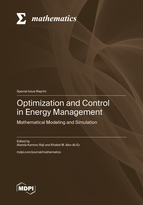Optimization and Control in Energy Management: Mathematical Modeling and Simulation
A special issue of Mathematics (ISSN 2227-7390). This special issue belongs to the section "Engineering Mathematics".
Deadline for manuscript submissions: closed (30 November 2023) | Viewed by 22491
Special Issue Editors
Interests: alternative and renewable energy systems; modeling and simulation; control algorithm; microgrid; power electronics
Special Issues, Collections and Topics in MDPI journals
Special Issue Information
Dear Colleagues,
The global energy crisis due to the depletion of fossil fuel resources, the need to reduce greenhouse emissions, the climate change phenomenon, and the unexpected increase in fuel prices due to global conflicts have increased the need to focus on using new and renewable energy systems. These systems can work autonomously and in a hybrid manner with other energy generation systems. The operation of these single or hybrid energy systems can be in the form of islanded or grid-connected mini or microgrids. Microgrid power fluctuation due to renewable energy systems requires energy storage systems to balance the energy and provides a continuous flow of energy even when energy fluctuates from renewable sources. Energy management strategies are essential in such systems for reliability, good power quality, and optimizing the operation of different energy and storage distributed systems in the microgrid. Energy Management Systems (EMS) are control techniques for managing the power flow in response to supply, demand, power quality, and storage conditions. We are pleased to invite the research community to submit a review or regular research papers on, but not limited to, the following relevant topics related to optimization and control in energy management:
- Demand side management and demand response
- Artificial intelligence optimization methods for renewable energy systems and energy management
- Frequency regulation using Virtual power plants
- Modeling and simulation for energy management
- EMS in smart electrical grids
- Energy-efficient systems
- Energy conservation techniques
- EMS in Mini and Micro-Grids
- Algorithms
- Numerical simulations
- Mathematical modeling
- Analytical understanding
- Control Theory
- Load and renewable energy generation prediction techniques
- Energy management for Smart cities and homes
- Energy management for improving power quality
- Various optimization techniques and methods in energy management systems
- Various control methods and strategies in energy management systems.
Dr. Atanda Kamoru Raji
Dr. Khaled M. Abo-Al-Ez
Guest Editors
Manuscript Submission Information
Manuscripts should be submitted online at www.mdpi.com by registering and logging in to this website. Once you are registered, click here to go to the submission form. Manuscripts can be submitted until the deadline. All submissions that pass pre-check are peer-reviewed. Accepted papers will be published continuously in the journal (as soon as accepted) and will be listed together on the special issue website. Research articles, review articles as well as short communications are invited. For planned papers, a title and short abstract (about 100 words) can be sent to the Editorial Office for announcement on this website.
Submitted manuscripts should not have been published previously, nor be under consideration for publication elsewhere (except conference proceedings papers). All manuscripts are thoroughly refereed through a single-blind peer-review process. A guide for authors and other relevant information for submission of manuscripts is available on the Instructions for Authors page. Mathematics is an international peer-reviewed open access semimonthly journal published by MDPI.
Please visit the Instructions for Authors page before submitting a manuscript. The Article Processing Charge (APC) for publication in this open access journal is 2600 CHF (Swiss Francs). Submitted papers should be well formatted and use good English. Authors may use MDPI's English editing service prior to publication or during author revisions.
Keywords
- energy management systems
- algorithms
- numerical simulations
- mathematical modelling
- analytical understanding
- control theory
- smart grids
- control of power electronics converters
- optimization techniques for energy managing
- hybrid electrical vehicles
- energy efficient systems
- energy conservation strategy
- artificial neural network
- optimal power flow
- optimization algorithm







